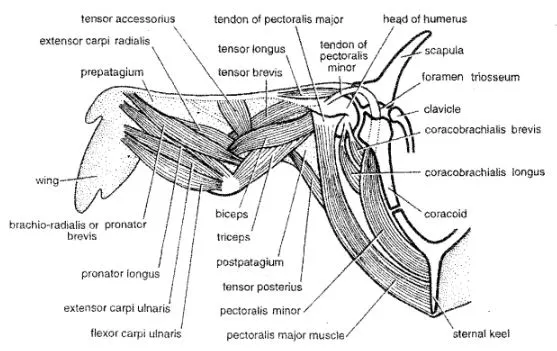The muscular system of Columba livia, also known as the domestic pigeon, is similar to that of most birds. Birds have a large number of flight muscles that allow them to generate the powerful forces necessary for flight. Other muscles in the pigeon’s body, such as the leg and breast muscles, help it maintain balance and maneuver while in flight.
Muscular System of Columba livia (Pigeon)
- The muscular system of a bird(Columba livia) is highly developed and the muscles are greatly specialized to serve different functions.
- As in other vertebrates, Columba livia also have three kinds of muscles and they are striated, unstriated, and cardiac.
- The most important muscles of the pigeon are flight, bipedal locomotion, and perching.
Flight Muscles

Fig: Flight muscles of the pigeon.
- The wings of the birds are the modified forelimbs.
- There are three main categories of flight muscles and they are pectoral, accessory, and tensor muscles.
1. Pectoral Muscles
- Pectoral muscles are the most important muscles.
- They are mainly responsible for the up and down movement of the wings during flight.
- These muscles are attached to the keel of the sternum and to the wings.
- Two pectoral muscles are present and they are pectoralis major and pectoralis minor.
A. Pectoralis Major
- They are two in number.
- These are the largest and most powerful flight muscle and is triangular in shape.
- They arise ventrally from the sternal keel and the clavicle, one on each side, and form the so-called breast.
- They are dark red in color because of the huge blood supply.
- These are the depressor muscles which means they are responsible for the downstroke of wings.
- When these muscles contract, the wings are pulled downwards and forwards, so that the body of the bird is lifted up and propels itself through the air.
B. Pectoralis Minor
- Pectoralis minor is an elevator muscle, which causes the upstroke of the wings.
- When these muscles contract, the wings are pulled upwards, so that the body of the bird is lifted down.
- It helps the pigeon in rapid take off during the flight.
- It lies on the sternum, in the angle between keel and body, beneath the pectoralis major.
2. Accessory Muscles
- Accessory muscles help in elevating or depressing the wings.
- Several small accessory muscles are present in pigeons such as coraco-brachialis longus, coraco-brachialis brevis, extensor carpi radialis, extensor carpi ulnaris, etc.
- Coraco-brachialis longus is a depressor muscle and triangular in shape. It lies beneath the pectoral muscles.
- Coraco-brachialis brevis is smaller and narrower than the coraco-brachialis longus and it helps to rotate the wings in the glenoid cavity.
- Extensor carpi radialis and extensor carpi ulnaris help the bird in the stretching and folding of the wings.
3. Tensor Muscles
- Some tensor muscles are tensor longus, tensor brevis, tensor accessorius and tensor posterius.
- The first three muscles keep the prepatagium fully stretched when the wing is spread out during flight.
- The tensor posterius muscle keeps the postpatagium stretched during flight.
Perching Muscles
- The muscles involved in the perching mechanism are known as perching muscles.
- Perching is quite automatic and it enables the bird even to sleep on a twig without any risk of falling down.
- Two types of muscles are responsible for the perching mechanism and they are flexor and extensor muscles.
1. Flexor Muscles
- A total of 8 flexor muscles (4 pairs) are present in the pigeon.
- Six of them are attached to the anterior toes.
- Two of them are attached to the hind toe or hallux.
A. Ambiens
- The ambiens arises from the anterior part of the pubis and extends down along the inner surface of the thigh.
- Its tendon runs to the second and third toes.
- Since the ambiens is connected with two toes only, it plays only a minor role in perching.
B. Peroneus medius
- This muscle is present on the anterior aspect of the shank.
- Peroneus medius is attached to the upper part of the tibiotarsus bone.
- Its tendon is divided into three parts to supply the three anterior toes.
C. Gastrocnemius
- This muscle is present on the back of the tibiotarsus.
- Its tendon also joins those of the peroneus muscles to supply the anterior toes.
- It is the big calf muscle.
D. Flexor perforans
- This muscle is also attached to the upper part of the tibiotarsus.
- Its tendon is supplied to the hind toe or the hallux.
- It is joined by a slip with the peroneus medius so that a pull on any tendon will flex all the toes.
2. Extensor Muscles
- Several extensor muscles are found at the front of the tibiotarsus.
- The tendon of the tibialis anterior muscle passes down in front of the inter-tarsal joint and then trifurcates to supply one branch to each anterior toe.
- Their contraction serves to open the toes when the bird raises its shank while taking off the perch.
———- THE END ———-
Read More:
- Feathers in Pigeon | Columba livia | Diagram
- Digestive System of Columba livia | Pigeon | Diagram | Note
- Air Sacs of Pigeon | Bird | Columba livia | Diagram | Note
- Skin and Exoskeleton of Columba livia | Pigeon | Diagram
- External Morphology of Columba livia | Pigeon | Diagram
- General Characters of All Classes of Vertebrates.
- The Sound Producing Organ in Birds | Syrinx | Diagram | Note
Reference:

Md Ekram Hossain Bhuiyan is a passionate student currently pursuing his studies at Jagannath University in Dhaka. He is a zoology major and his love for animals, nature, and wildlife is evident in his academic pursuits. Ekram is a curious and adventurous individual who always seeks to learn more about the world around him. His passion for animals began at a young age, and he has since dedicated himself to studying the behavior, anatomy, and habitats of various species.
He finds peace in being surrounded by the beauty of nature and observing the creatures that call it home. He believes that it is important to protect and preserve the natural world for future generations.
As a student of zoology, Ekram is dedicated to expanding his knowledge of the subject. He is a hardworking individual who strives for excellence in his studies and is always eager to take on new challenges. Ekram is a driven and compassionate individual who is dedicated to his studies and his passion for animals, nature, and wildlife.